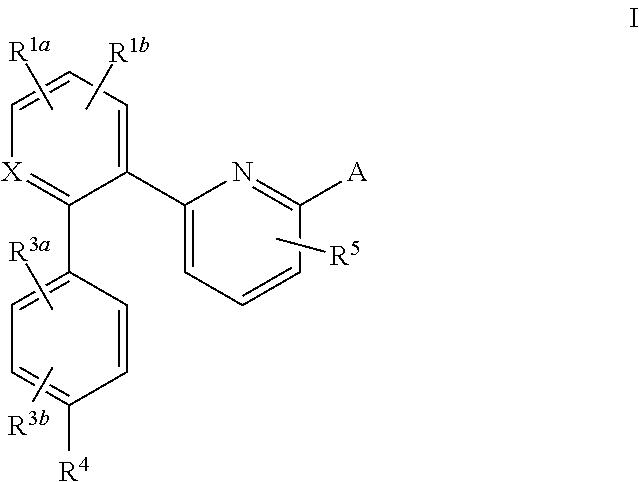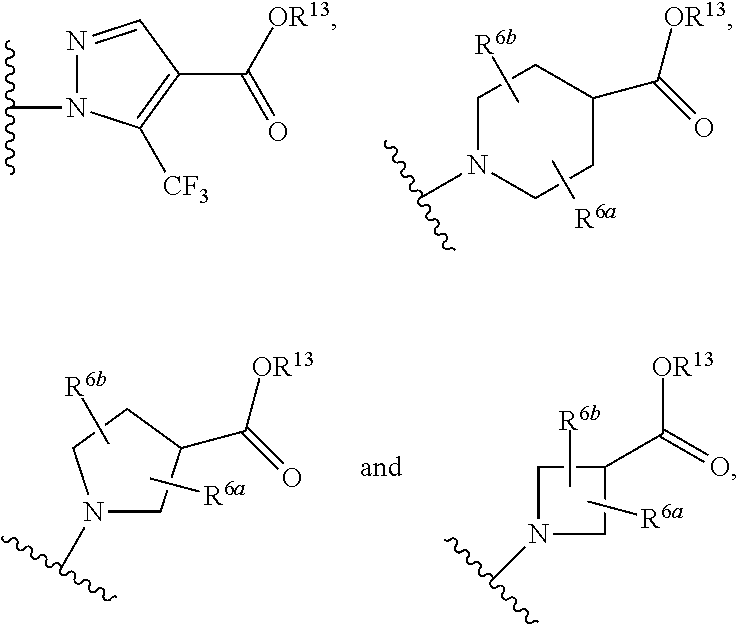Soluble guanylate cyclase activators
a technology of guanylate cyclase and activator, which is applied in the direction of biocide, cardiovascular disorder, drug composition, etc., can solve the problems of increased dosage, increased tolerance, and increased risk of cardiovascular disease, and achieve the effect of disease therapy and prophylaxis
- Summary
- Abstract
- Description
- Claims
- Application Information
AI Technical Summary
Benefits of technology
Problems solved by technology
Method used
Image
Examples
example 1a and 1b
[0131]
Step A. Ethyl 1-(6-chloropyridin-2-yl)-5-(trifluoromethyl)-1H-pyrazole-4-carboxylate
[0132]
[0133]To a solution 2-chloro-6-hydrazinopyridine (1.00 g, 6.97 mmol) and triethylamine (971 mL, 6.97 mmol) in acetonitrile (35 mL) was added ethyl 2-(ethoxymethylene)-4,4,4-trifluoro-3-oxobutyrate (1.36 mL, 6.97 mmol). After 20 min, the reaction mixture was placed in a 60° C. oil bath. After 30 min, the reaction mixture was allowed to cool to ambient temperature, then was concentrated in vacuo. Purification by flash chromatography on silica gel (0 to 30% EtOAc in hexanes, then 30 to 100% EtOAc in hexanes) gave the title compound (PCT publication WO 2009 / 032249): LCMS m / z 319.9 [M+H]; 1H NMR (500 MHz, CDCl3) δ 8.10 (s, 1H), 7.88 (t, J=7.5 Hz, 1H), 7.58 (d, J=8.0 Hz, 1H), 7.47 (d, J=8.0 Hz, 1H), 4.38 (q, J=7.0 Hz, 2H), 1.38 (t, J=7.0 Hz, 3H).
Step B. Ethyl 1-[6-(2-methoxy-5-methylphenyl)pyridin-2-yl]-5-(trifluoromethyl)-1H-pyrazole-4-carboxylate
[0134]
[0135]To a flask containing the title com...
example 2
[0152]
1-{6-[4′-(4-methoxycyclohex-1-en-1-yl)-4-methylbiphenyl-2-yl]pyridin-2-yl}-5-(trifluoromethyl)-1H-pyrazole-4-carboxylic acid
[0153]To a solution of the title compound from Example 1 Step H (49.6 mg, 0.09 mmol) in 1,4-dioxane (0.5 mL) was added sodium hydroxide (0.18 mL of 1.0 M solution in water, 0.18 mmol), and the resulting mixture was stirred at 60° C. After 15 min, the reaction mixture was rendered acidic by addition of 2N trifluoroacetic acid in DMSO, then was diluted with 2:1 dioxane:water and passed through a 0.45 μm syringe filter. Purification by reverse phase HPLC (30 to 100% acetonitrile in water, each with 0.1% v / v TFA) provided the title compound: LCMS m / z 533.9 [M+H]+; 1H NMR (500 MHz, CD2Cl2) δ 8.21 (s, 1H), 7.61 (t, J=7.8, 1H), 7.54 (s, 1H), 7.46 (d, J=7.8 Hz, 1H), 7.37-7.27 (m, 4H), 7.10 (d, J=8.1 Hz, 2H), 6.98 (d, J=7.7 Hz, 1H), 6.04 (m, 1H), 3.59-3.52 (m, 1H), 3.38 (s, 3H), 2.59-2.51 (m, 2H), 2.44 (m, 4H), 2.24-2.16 (m, 1H), 2.08-2.00 (m, 1H), 1.84-1.74 (m, 1...
example 3
[0154]
1-(6-{4′-[4-(2-hydroxypropan-2-yl)piperidin-1-yl]-4-methylbiphenyl-2-yl}pyridin-2-yl)-5-(trifluoromethyl)-1H-pyrazole-4-carboxylic acid
[0155]To a solution of the title compound from Example 1 Step F (58.5 mg, 0.10 mmol) in toluene (1.5 mL) were added 2-(piperidin-4-yl)propan-2-ol (30.0 mg, 0.15 mmol), tris(dibenzylidene acetone) dipalladium (0) (4.5 mg, 0.005 mmol), 2-(di-tert-butyl(phosphino)-2″-methylbiphenyl (3.1 mg, 0.01 mmol), and potassium phosphate tribasic (62.1 mg, 0.29 mmol). The resulting mixture was degassed via nitrogen sparge. The mixture was then placed in a pre-heated oil bath (85° C.), and was held at this temperature for 1 h, whereupon it was allowed to cool to ambient temperature, then was poured into water and then extracted with EtOAc. The organic phase was separated, dried over sodium sulfate, filtered through a silica plug, and concentrated in vacuo. The crude material was dissolved in 1,4-dioxane (0.5 mL) and a solution of sodium hydroxide (0.1 ml, 1.0 ...
PUM
| Property | Measurement | Unit |
|---|---|---|
| weight | aaaaa | aaaaa |
| weight | aaaaa | aaaaa |
| flow rate | aaaaa | aaaaa |
Abstract
Description
Claims
Application Information
 Login to View More
Login to View More - R&D
- Intellectual Property
- Life Sciences
- Materials
- Tech Scout
- Unparalleled Data Quality
- Higher Quality Content
- 60% Fewer Hallucinations
Browse by: Latest US Patents, China's latest patents, Technical Efficacy Thesaurus, Application Domain, Technology Topic, Popular Technical Reports.
© 2025 PatSnap. All rights reserved.Legal|Privacy policy|Modern Slavery Act Transparency Statement|Sitemap|About US| Contact US: help@patsnap.com



